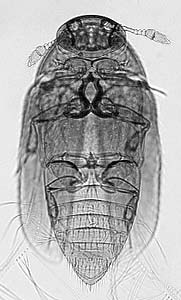Throscoptilium
Throscoptilium duryi
W. Eugene HallIntroduction
Throscoptilium is currently composed of one described species, T. duryi (Barber 1924, Dybas 1990), and is associated with the polypore fungus Phellinus gilvus (= Polyporus gilvus). Dybas (1976: 52) notes that though the adults are active on the upper and lower surface of the host fungus, "Unlike Nanosella and allies, adults of this genus do not crawl into the spore tubes - they are too broad to fit into tubes of this diameter."
The spermatheca, used to distinguish ptiliid species, is erroneously illustrated in Barber's paper, the distortion most likely an artifact of clearing the specimen with potassium hydroxide in preparation for mounting on a microscope slide.
Characteristics
Throscoptilium can be distinguished from other nanosellines by its stout form, which is widest at posterior angles of the pronotum. The mesosternal process somewhat resembles that of Suterina.
Dybas (1976) provides a description/illustration of the larva from specimens collected in Indiana. Dybas noted that when larvae enter into a spore tube head first, the exposed abdominal tip coloration resembles that of the fungus surface.
Geographic Distribution
The type locality for Throscoptilium duryi is listed as "near Cincinnati, Ohio" (Barber, 1924: 175). Dybas (1990) states the species occurs in the eastern United Sates.
References
Barber, H.S. 1924. New Ptiliidae related to the smallest known beetle. Proc. Ent. Soc. Wash. 26(6): 167 - 178.
Dybas, H.S. 1990. Ptiliidae. in Soil Biology Guide, Daniel L. Dindail, editor. Wiley-Interscience, New York.
Dybas, H.S. 1976. The larval characters of featherwing and limulodid beetles and their family relationships in the Staphylinoidea (Coleoptera: Ptiliidae and Limulodidae). Fieldiana. Zoology. 70(3): 29 - 78.
Title Illustrations

| Scientific Name | Throscoptilium duryi |
|---|---|
| Image Use |
 This media file is licensed under the Creative Commons Attribution-NonCommercial-ShareAlike License - Version 3.0. This media file is licensed under the Creative Commons Attribution-NonCommercial-ShareAlike License - Version 3.0.
|
| Copyright |
© 1997

|
About This Page
Page copyright © 1997
 Page: Tree of Life
Throscoptilium. Throscoptilium duryi.
Authored by
W. Eugene Hall.
The TEXT of this page is licensed under the
Creative Commons Attribution-NonCommercial-ShareAlike License - Version 3.0. Note that images and other media
featured on this page are each governed by their own license, and they may or may not be available
for reuse. Click on an image or a media link to access the media data window, which provides the
relevant licensing information. For the general terms and conditions of ToL material reuse and
redistribution, please see the Tree of Life Copyright
Policies.
Page: Tree of Life
Throscoptilium. Throscoptilium duryi.
Authored by
W. Eugene Hall.
The TEXT of this page is licensed under the
Creative Commons Attribution-NonCommercial-ShareAlike License - Version 3.0. Note that images and other media
featured on this page are each governed by their own license, and they may or may not be available
for reuse. Click on an image or a media link to access the media data window, which provides the
relevant licensing information. For the general terms and conditions of ToL material reuse and
redistribution, please see the Tree of Life Copyright
Policies.
Citing this page:
Hall, W. Eugene. 1997. Throscoptilium. Throscoptilium duryi. Version 01 January 1997 (under construction). http://tolweb.org/Throscoptilium_duryi/9653/1997.01.01 in The Tree of Life Web Project, http://tolweb.org/








 Go to quick links
Go to quick search
Go to navigation for this section of the ToL site
Go to detailed links for the ToL site
Go to quick links
Go to quick search
Go to navigation for this section of the ToL site
Go to detailed links for the ToL site